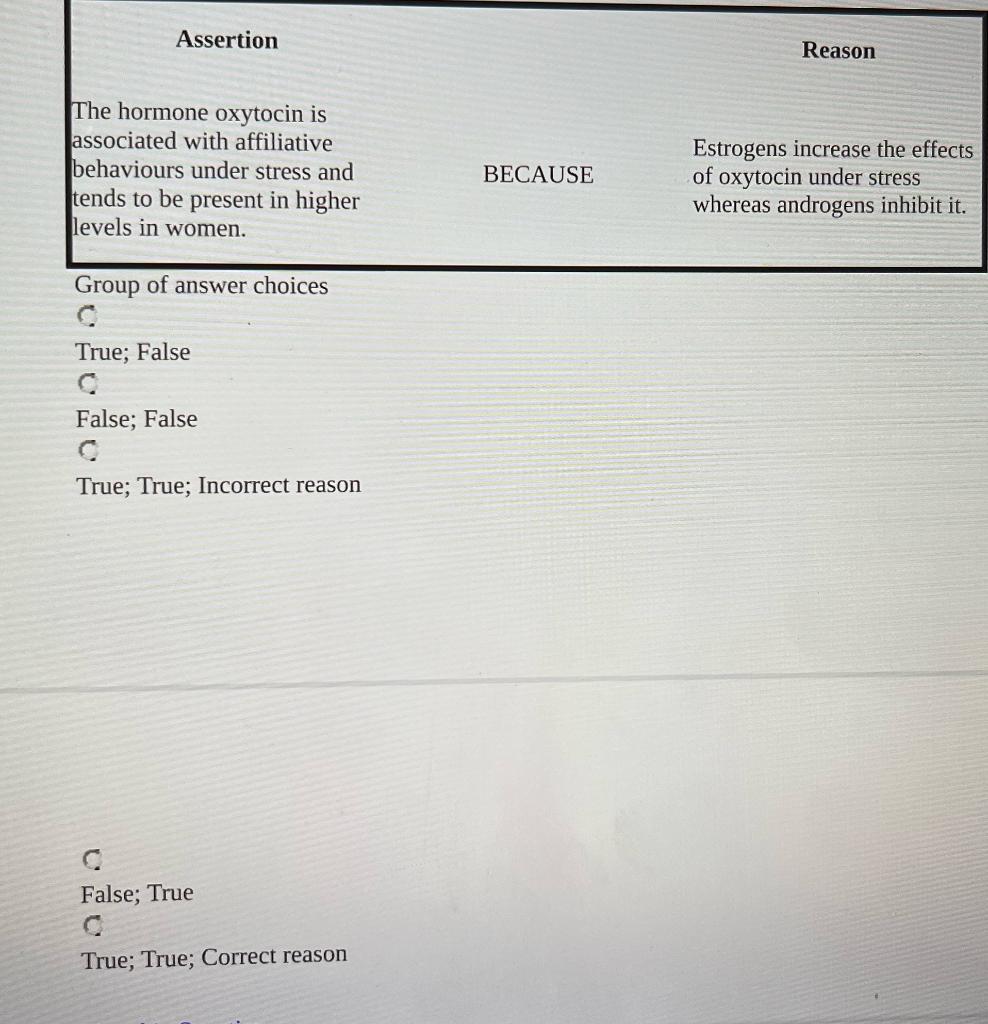QQuestionAnatomy and Physiology
QuestionAnatomy and Physiology
| Assertion | Reason |
| --- | --- |
| The hormone oxytocin is associated with affiliative behaviours under stress and tends to be present in higher levels in women. | Estrogens increase the effects of oxytocin under stress whereas androgens inhibit it. |
| Group of answer choices | |
| True; False | |
| False; False | |
| True; True; Incorrect reason | |
| | |
| False; True | |
| True; True; Correct reason | |
Attachments

6 months agoReport content
Answer
Full Solution Locked
Sign in to view the complete step-by-step solution and unlock all study resources.
Step 1: Identify the assertion and reason
The assertion is that the hormone oxytocin is associated with affiliative behaviors under stress and tends to be present in higher levels in women. The reason given is that estrogens increase the effects of oxytocin under stress whereas androgens inhibit it.
Step 2: Analyze the assertion and reason
The assertion is generally correct. Oxytocin has been shown to play a role in social bonding, maternal behavior, and stress reduction (Heinrichs et al., 2003). Furthermore, women tend to have higher oxytocin levels than men (Taylor et al., 2000). The reason given, however, requires further examination. While it is true that estrogens can enhance the effects of oxytocin (Uvnäs-Moberg, 1998), androgens do not necessarily inhibit oxytocin's effects. Instead, testosterone, an androgen, has been found to have mixed effects on oxytocin, with some studies suggesting that it may inhibit oxytocin release (Eisenegger et al., 2010) and others indicating that it may facilitate oxytocin release under certain conditions (Albert et al., 2011).
Final Answer
The assertion is true: oxytocin is associated with affiliative behaviors under stress and tends to be present in higher levels in women. However, the reason provided is partially incorrect, as androgens do not uniformly inhibit oxytocin's effects. Assertion: True Reason: False References: Albert, P. R., Walton, K. E., Svetkey, L. P., & Frazier, S. A. (2011). Testosterone and oxytocin: a complex relationship. Hormones and behavior, 59(5), 722 - 730. Eisenegger, C., Naef, M., Snozzi, R., Heinrichs, M., & Aguilar-Rozzi, A. (2010). Prejudice and truth about the effect of testosterone on human social behavior. Journal of neuroscience, 30(46), 15640 - 15645. Heinrichs, M., Baumgartner, T., Kirschbaum, C., & Ehlert, U. (2003). Social support and oxytocin release in humans: effects of different types of interaction. Psychoneuroendocrinology, 28(7), 931 - 941. Taylor, S. E., Klein, L. C., Lewis, B. P., Gruenewald, T. L., Gurung, R. A., & Updegraff, J. A. (2000). Biobehavioral responses to stress in females: tend-and-befriend, not fight-or-flight. Psychological review, 107(3), 411. Uvnäs-Moberg, K. (1998). Oxytocin may mediate the benefits of positive social interaction and emotions. Psychoneuroendocrinology, 23(8), 779 - 788.
Need Help with Homework?
Stuck on a difficult problem? We've got you covered:
- Post your question or upload an image
- Get instant step-by-step solutions
- Learn from our AI and community of students